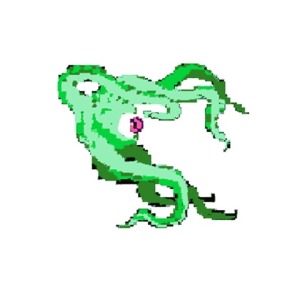The Kamprad-Lovecraft correspondences was an intertextual project that was initially developed as a contribution to Wendel! Open Your Door, at Cafe Gallery Projects in July 2013.
The project imagines an alternate reality where the 10 year-old future founder of IKEA and American cosmic horror writer H.P. Lovecraft exchanged letters which exerted a subtle, yet important influence on the legacies of each. So much so that various historical figures, fictional characters and contemporary individuals are drawn in to a tenuous web of fictions, which obliquely relate to discrete objects, images and events IRL. Find out more here.

The Shuma-Gorath tangent

Shuma-Gorath is a fictional Lovecraftian mystical entity first mentioned by pulp author and creator of Conan the Barbarian, Robert E. Howard. Howard was a prominent member of the Lovecraft Circle of writers who collaborated via correspondence and created a detailed ‘mythos’ as a basis for their ventures into weird fiction, horror, science fiction and fantasy. The Lovecraft Circle was a small part of broader network of writers and illustrators in the late 1920-30s, who spanned the United States and began to blur the boundaries between fan fiction, pulp and literature. The focal point for this disparate group of writers and illustrators was Weird Tales, a pulp magazine based in Chicago that welcomed submissions and paid a small fee on publication. While some contributors went on to attain mainstream literary recognition, others fell into obscurity and succumbed to disease, starvation and suicide.
Shuma-Gorath first appears as an obscure reference in the Howard short story The Curse of the Golden Skull, which is thought to have been written in 1928, two years before Howard and Lovecraft began their life-long correspondence. It is unclear whether Howard intended Shuma-Gorath as a homage or parody of Lovecraft’s malign yet indifferent deities, or if the Lovecraftian elements were added by Marvel who acquired the rights to publish comics based on the Conan stories in 1970. Either way, Shuma-Gorath shares many of the formal and conceptual conventions of a canonical Cthulu Mythos entity.
In the Marvel universe, Shuma-Gorath is an antagonist of Doctor Strange, a human sorcerer changed with the protection of earth. Shuma-Gorath is described as one of the ‘Old Ones’, inhabiting an ‘extra-dimensional realm’ and having once ruled over earth as he now rules over countless alternate universes. Shuma-Gorath is one of the most powerful entities in the Marvel universe, but has made very few appearances since its debut in 1972. This made its inclusion as one of only ten playable characters in the 1995 Capcom arcade game Marvel Super Heroes particularly surprising.
Recollections
My first encounter with Shuma-Gorath was as a playable character in the Capcom tag-team fighter Marvel Super Heroes vs Street Fighter (1997). It was a game I had gone to great lengths to acquire, purchasing a Sega Saturn and having it customised to play UK, US and Japanese games across both 50 and 60hz. This work was done by an independent computer games shop just off Carnaby Street in Soho, which now seems hard to believe. The game itself was on a CD, but required additional RAM in the form of a cartridge that was oddly heavy for its size and redolent of some oblique object of power.
The Japanese version of the game came bundled with the RAM cartridge and was purchased from a specialist rare games shop in Bromley. It was tracked down through whispered exchanges with taciturn independent games shop owners in crumbling, suburban indoor markets, and half heard rumours caught over the maelstrom of discordant arcade bleeps and roars. It was always “Yeah, my cousin used to have it” or “Wait for the arcade-perfect PlayStation version to come out next year”*. I was fifteen and this was before the obscure could be discovered, purchased and delivered in a matter of days. There was space for obsession to truly take hold.
After months of frustrated efforts and a small fortune in spending money advances, I had the game and a system that could play it. I was ready to recreate the intensity of competitive arcade gaming that I had first experienced playing Street Fighter II as a kid in my local video shop. This was a time when home gaming aspired to the graphics and power of the arcade, and achieving an ‘arcade-perfect’ experience was the holy grail of console gaming.
Following the first few weeks of frenzied tag-team battles with my brother and friends, the appeal of playing with the more conventional characters began to wane. This is when I first began experimenting with Shuma-Gorath as a tactical option to employ against more standard pairings. The obscurity of the character made it an unpopular choice among my cohort of challengers, which meant becoming fluent with its moves and combinations provided a more awkward opponent. Shuma-Gorath was also beautifully animated and the most bizarre in appearance of all of the characters in the game. It reminded my then teenage self of the be-tentacled characters I had first encountered in the erotic Manga films that circulated locally on copied video cassettes.
A generative, self-perpetuating combination of letters

“The iron-bound books of Shuma-Gorath”
The above quotation is the first (and possibly only) mention of Shuma- Gorath in the writings of Robert E. Howard. It featured in a short story where the iron-bound books in question are invoked by a dying magician in a curse against humanity. What I find compelling about Shuma-Gorath is that from the merest, most incidental reference in an obscure pulp short story in 1928, it has gone on to feature in comics and computer games up to the present day.
Yet, despite its intertextual proliferation, Shuma-Gorath remains strangely vacant and unknowable. It’s as if its persistence is reluctantly granted – a last resort antagonist whose obscure origins lend it a plasticity that makes it valuable as a plot device, but uninteresting as a character. As the creation of Shuma-Gorath in any comprehensive fashion cannot be ascribed to any one author, it is an orphaned, incidentally collaborative entity whose power and scale precludes any fleshing out of its character.
The very combination of letters that make up the name ‘Shuma-Gorath’ seems to have a generative quality that demands its perpetuation; it wants to be written and spoken, like a nonsense mantra to obscurity, otherness and occult MacGuffin. The formal qualities of the words, the operation of naming and its conceptual plasticity lends Shuma-Gorath an almost fractal quality. Indeed, much of the artwork in the Doctor Strange comics in which Shuma-Gorath appeared was renowned for its psychedelic aesthetic, something it shares with that multi-coloured, schizophrenic bombast of the Marvel vs games.
*The Playstation version of the previous incarnation of the game, X-Men Vs Street Fighter, was critically panned, being compromised by the PlayStation’s lack of RAM.